Evaluating Valuation and Capital Appraisal Techniques in Finance
VerifiedAdded on 2023/06/18
|16
|4063
|458
Report
AI Summary
This report provides a comprehensive analysis of financial valuation and capital appraisal techniques. It begins by valuing a company using the price/earnings ratio, dividend valuation method, and discounted cash flow (DCF) method, discussing the problems associated with each. The report then evaluates capital appraisal techniques, including payback period (PP), accounting rate of return (ARR), net present value (NPV), and internal rate of return (IRR), highlighting the benefits and drawbacks of each method. The analysis includes calculations and interpretations to determine the economic feasibility of investment decisions, offering insights into how companies can effectively assess and manage their financial strategies. The solutions are provided by students on Desklib, a website providing necessary AI based study tools.

FINANCIAL
MANAGEMENT
MANAGEMENT
Paraphrase This Document
Need a fresh take? Get an instant paraphrase of this document with our AI Paraphraser

TABLE OF CONTENTS
QUESTION 2..................................................................................................................................3
a) Calculation of valuation of company by using price/ earning ratio.......................................3
b) Computation of valuation of Trojan plc by Dividend valuation method................................4
c) Estimation of organization's value via Discounted cash flow method...................................5
d) Discussing the problem associated with valuation techniques..............................................6
QUESTION 3..................................................................................................................................8
a) Payback Period (PP)................................................................................................................8
b) Accounting Rate of Return (ARR)..........................................................................................9
c) Net present value (NPV)..........................................................................................................9
d) Internal Rate of return (IRR)................................................................................................10
Evaluating the benefits and drawbacks of capital appraisal techniques....................................12
REFERENCES..............................................................................................................................15
QUESTION 2..................................................................................................................................3
a) Calculation of valuation of company by using price/ earning ratio.......................................3
b) Computation of valuation of Trojan plc by Dividend valuation method................................4
c) Estimation of organization's value via Discounted cash flow method...................................5
d) Discussing the problem associated with valuation techniques..............................................6
QUESTION 3..................................................................................................................................8
a) Payback Period (PP)................................................................................................................8
b) Accounting Rate of Return (ARR)..........................................................................................9
c) Net present value (NPV)..........................................................................................................9
d) Internal Rate of return (IRR)................................................................................................10
Evaluating the benefits and drawbacks of capital appraisal techniques....................................12
REFERENCES..............................................................................................................................15
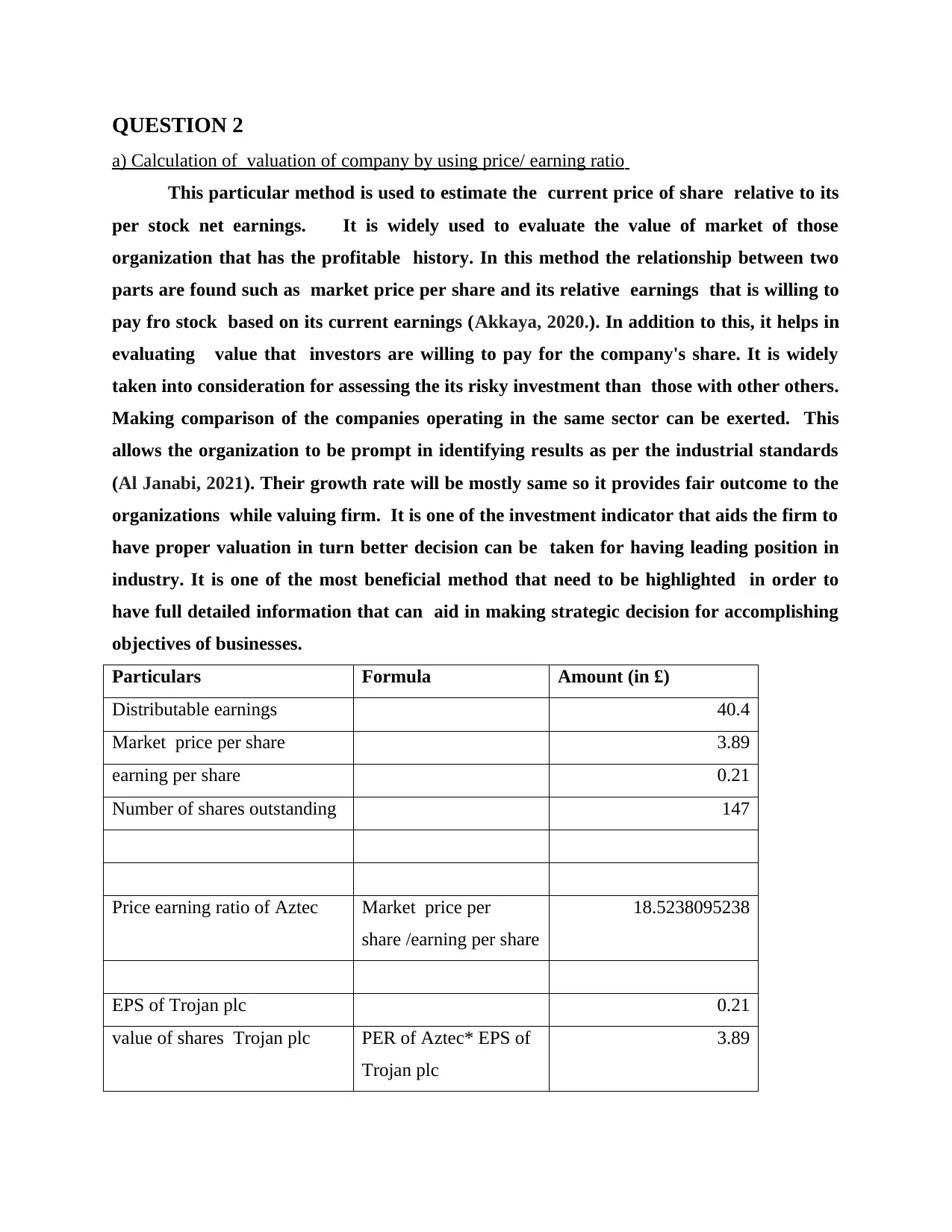
QUESTION 2
a) Calculation of valuation of company by using price/ earning ratio
This particular method is used to estimate the current price of share relative to its
per stock net earnings. It is widely used to evaluate the value of market of those
organization that has the profitable history. In this method the relationship between two
parts are found such as market price per share and its relative earnings that is willing to
pay fro stock based on its current earnings (Akkaya, 2020.). In addition to this, it helps in
evaluating value that investors are willing to pay for the company's share. It is widely
taken into consideration for assessing the its risky investment than those with other others.
Making comparison of the companies operating in the same sector can be exerted. This
allows the organization to be prompt in identifying results as per the industrial standards
(Al Janabi, 2021). Their growth rate will be mostly same so it provides fair outcome to the
organizations while valuing firm. It is one of the investment indicator that aids the firm to
have proper valuation in turn better decision can be taken for having leading position in
industry. It is one of the most beneficial method that need to be highlighted in order to
have full detailed information that can aid in making strategic decision for accomplishing
objectives of businesses.
Particulars Formula Amount (in £)
Distributable earnings 40.4
Market price per share 3.89
earning per share 0.21
Number of shares outstanding 147
Price earning ratio of Aztec Market price per
share /earning per share
18.5238095238
EPS of Trojan plc 0.21
value of shares Trojan plc PER of Aztec* EPS of
Trojan plc
3.89
a) Calculation of valuation of company by using price/ earning ratio
This particular method is used to estimate the current price of share relative to its
per stock net earnings. It is widely used to evaluate the value of market of those
organization that has the profitable history. In this method the relationship between two
parts are found such as market price per share and its relative earnings that is willing to
pay fro stock based on its current earnings (Akkaya, 2020.). In addition to this, it helps in
evaluating value that investors are willing to pay for the company's share. It is widely
taken into consideration for assessing the its risky investment than those with other others.
Making comparison of the companies operating in the same sector can be exerted. This
allows the organization to be prompt in identifying results as per the industrial standards
(Al Janabi, 2021). Their growth rate will be mostly same so it provides fair outcome to the
organizations while valuing firm. It is one of the investment indicator that aids the firm to
have proper valuation in turn better decision can be taken for having leading position in
industry. It is one of the most beneficial method that need to be highlighted in order to
have full detailed information that can aid in making strategic decision for accomplishing
objectives of businesses.
Particulars Formula Amount (in £)
Distributable earnings 40.4
Market price per share 3.89
earning per share 0.21
Number of shares outstanding 147
Price earning ratio of Aztec Market price per
share /earning per share
18.5238095238
EPS of Trojan plc 0.21
value of shares Trojan plc PER of Aztec* EPS of
Trojan plc
3.89
⊘ This is a preview!⊘
Do you want full access?
Subscribe today to unlock all pages.

Trusted by 1+ million students worldwide
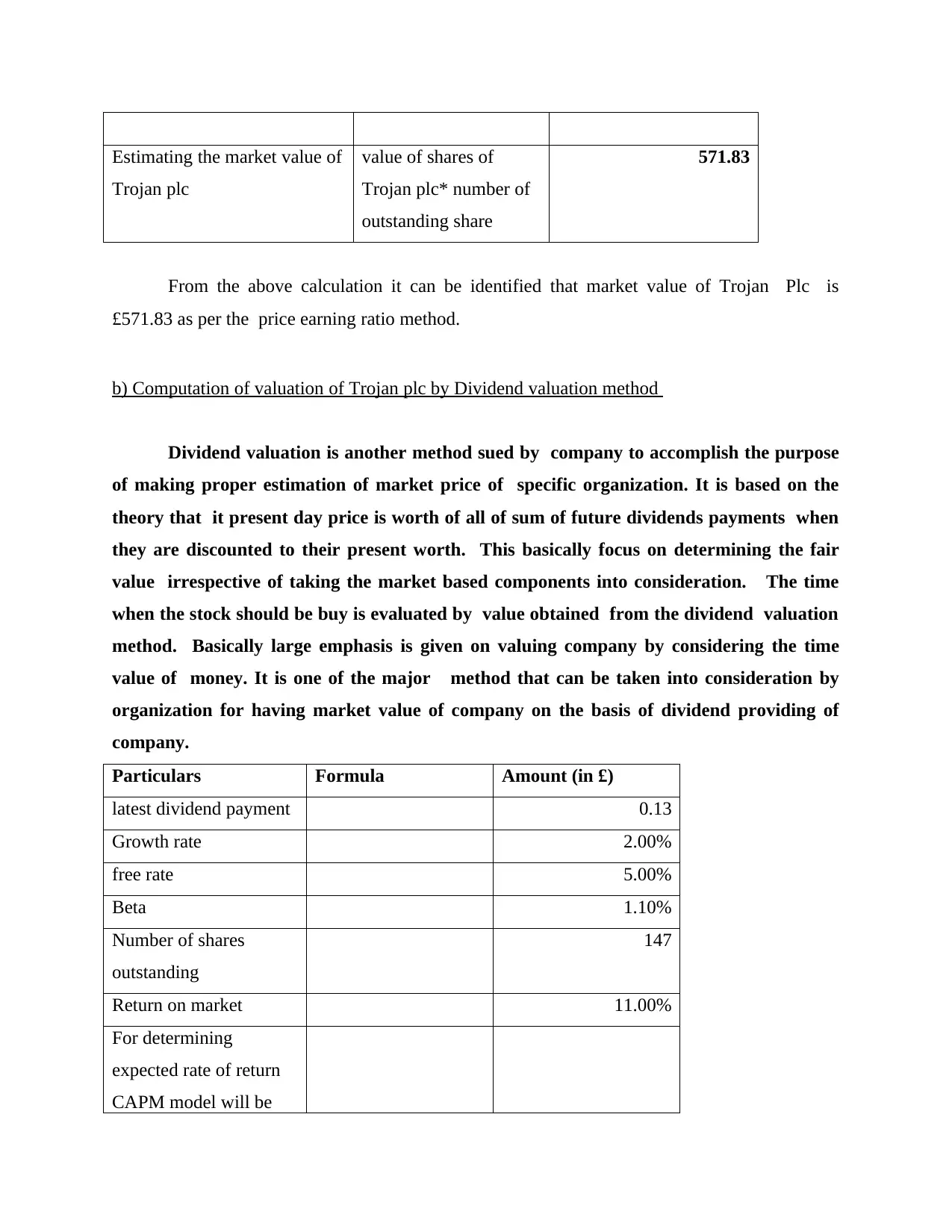
Estimating the market value of
Trojan plc
value of shares of
Trojan plc* number of
outstanding share
571.83
From the above calculation it can be identified that market value of Trojan Plc is
£571.83 as per the price earning ratio method.
b) Computation of valuation of Trojan plc by Dividend valuation method
Dividend valuation is another method sued by company to accomplish the purpose
of making proper estimation of market price of specific organization. It is based on the
theory that it present day price is worth of all of sum of future dividends payments when
they are discounted to their present worth. This basically focus on determining the fair
value irrespective of taking the market based components into consideration. The time
when the stock should be buy is evaluated by value obtained from the dividend valuation
method. Basically large emphasis is given on valuing company by considering the time
value of money. It is one of the major method that can be taken into consideration by
organization for having market value of company on the basis of dividend providing of
company.
Particulars Formula Amount (in £)
latest dividend payment 0.13
Growth rate 2.00%
free rate 5.00%
Beta 1.10%
Number of shares
outstanding
147
Return on market 11.00%
For determining
expected rate of return
CAPM model will be
Trojan plc
value of shares of
Trojan plc* number of
outstanding share
571.83
From the above calculation it can be identified that market value of Trojan Plc is
£571.83 as per the price earning ratio method.
b) Computation of valuation of Trojan plc by Dividend valuation method
Dividend valuation is another method sued by company to accomplish the purpose
of making proper estimation of market price of specific organization. It is based on the
theory that it present day price is worth of all of sum of future dividends payments when
they are discounted to their present worth. This basically focus on determining the fair
value irrespective of taking the market based components into consideration. The time
when the stock should be buy is evaluated by value obtained from the dividend valuation
method. Basically large emphasis is given on valuing company by considering the time
value of money. It is one of the major method that can be taken into consideration by
organization for having market value of company on the basis of dividend providing of
company.
Particulars Formula Amount (in £)
latest dividend payment 0.13
Growth rate 2.00%
free rate 5.00%
Beta 1.10%
Number of shares
outstanding
147
Return on market 11.00%
For determining
expected rate of return
CAPM model will be
Paraphrase This Document
Need a fresh take? Get an instant paraphrase of this document with our AI Paraphraser

applied
As per CAPM model,
expected rate of return
Rf+ (Rm-Rf)*Beta 5%+ (11%-
5%)*1.10%
5.10%
Market value per share 0.13* (1+2%)/(5% -
2%)
2.706
Evaluating the market
value of Trojan plc
Market price per share
* number of shares
397.782
On the basis of above table illustrated it can be articulated that £397.782 by taking the
dividend valuation method into consideration.
c) Estimation of organization's value via Discounted cash flow method
This is one of the method used by companies on large scale for the purpose of valuing
company on the basis of future expected cash flows. This is sued by companies for evaluating
the decision that they should acquire, invest in technologies, make capital expenditure, etc. It
allows the company to be prompt in decision making for having significant advantages in terms
of gaining higher level of profitability for purpose of achieving sustainability (The Advantages
and Limitations of Discounted Cash Flow Analysis, 2021). The present value of expected cash
flow is determined by focusing on discount rate. This method give consideration on relying on
estimation of future cash flow which could prove inaccurate. There are various advantages of
using this particular technique into implementation which includes extremely detailed and
suitable for analysing the merger and acquisition. On the other side the limitation includes the
overcomplexity, very sensitive, overconfidence, etc.
Particulars Formula Amount (in £)
Evaluating free cash flows 40.4
As per CAPM model,
expected rate of return
Rf+ (Rm-Rf)*Beta 5%+ (11%-
5%)*1.10%
5.10%
Market value per share 0.13* (1+2%)/(5% -
2%)
2.706
Evaluating the market
value of Trojan plc
Market price per share
* number of shares
397.782
On the basis of above table illustrated it can be articulated that £397.782 by taking the
dividend valuation method into consideration.
c) Estimation of organization's value via Discounted cash flow method
This is one of the method used by companies on large scale for the purpose of valuing
company on the basis of future expected cash flows. This is sued by companies for evaluating
the decision that they should acquire, invest in technologies, make capital expenditure, etc. It
allows the company to be prompt in decision making for having significant advantages in terms
of gaining higher level of profitability for purpose of achieving sustainability (The Advantages
and Limitations of Discounted Cash Flow Analysis, 2021). The present value of expected cash
flow is determined by focusing on discount rate. This method give consideration on relying on
estimation of future cash flow which could prove inaccurate. There are various advantages of
using this particular technique into implementation which includes extremely detailed and
suitable for analysing the merger and acquisition. On the other side the limitation includes the
overcomplexity, very sensitive, overconfidence, etc.
Particulars Formula Amount (in £)
Evaluating free cash flows 40.4
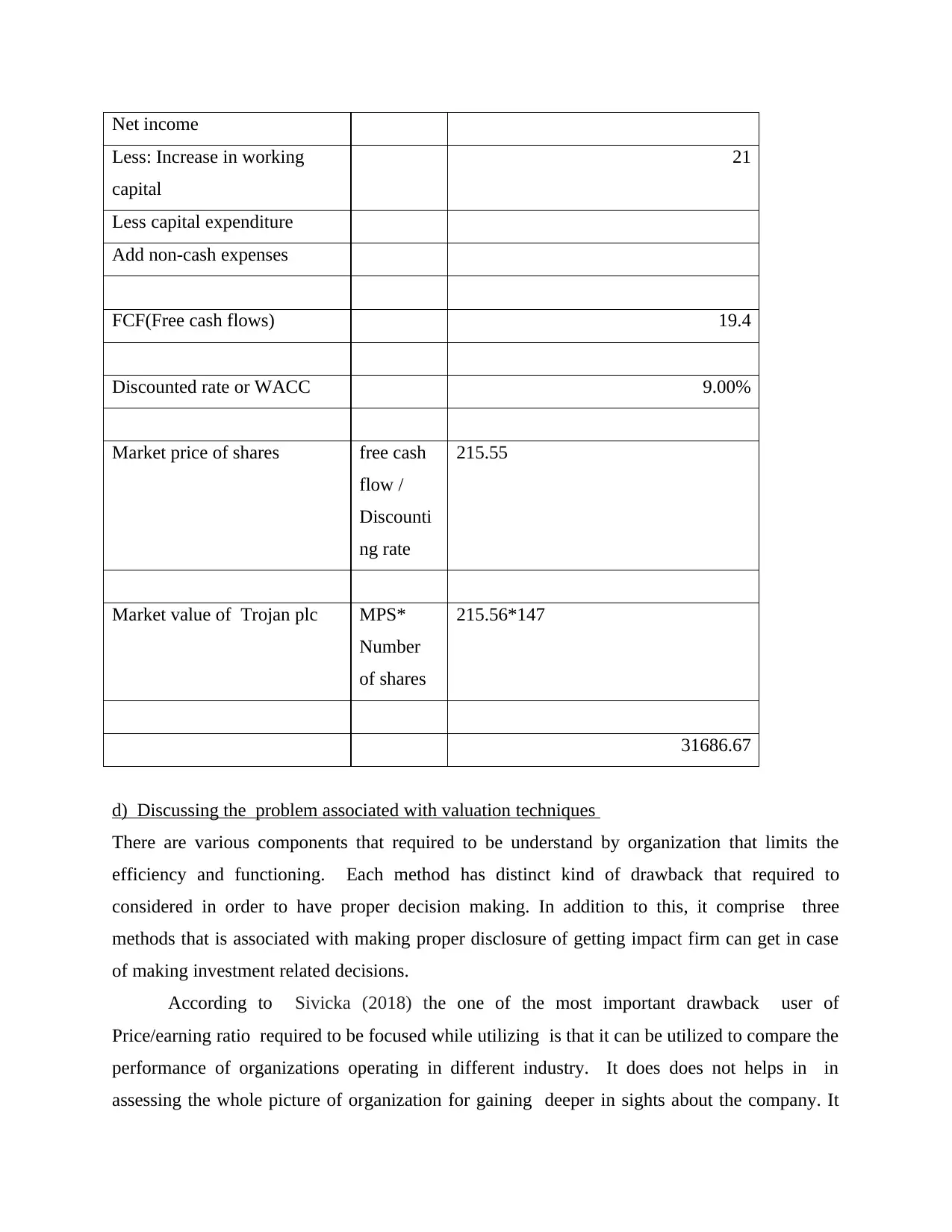
Net income
Less: Increase in working
capital
21
Less capital expenditure
Add non-cash expenses
FCF(Free cash flows) 19.4
Discounted rate or WACC 9.00%
Market price of shares free cash
flow /
Discounti
ng rate
215.55
Market value of Trojan plc MPS*
Number
of shares
215.56*147
31686.67
d) Discussing the problem associated with valuation techniques
There are various components that required to be understand by organization that limits the
efficiency and functioning. Each method has distinct kind of drawback that required to
considered in order to have proper decision making. In addition to this, it comprise three
methods that is associated with making proper disclosure of getting impact firm can get in case
of making investment related decisions.
According to Sivicka (2018) the one of the most important drawback user of
Price/earning ratio required to be focused while utilizing is that it can be utilized to compare the
performance of organizations operating in different industry. It does does not helps in in
assessing the whole picture of organization for gaining deeper in sights about the company. It
Less: Increase in working
capital
21
Less capital expenditure
Add non-cash expenses
FCF(Free cash flows) 19.4
Discounted rate or WACC 9.00%
Market price of shares free cash
flow /
Discounti
ng rate
215.55
Market value of Trojan plc MPS*
Number
of shares
215.56*147
31686.67
d) Discussing the problem associated with valuation techniques
There are various components that required to be understand by organization that limits the
efficiency and functioning. Each method has distinct kind of drawback that required to
considered in order to have proper decision making. In addition to this, it comprise three
methods that is associated with making proper disclosure of getting impact firm can get in case
of making investment related decisions.
According to Sivicka (2018) the one of the most important drawback user of
Price/earning ratio required to be focused while utilizing is that it can be utilized to compare the
performance of organizations operating in different industry. It does does not helps in in
assessing the whole picture of organization for gaining deeper in sights about the company. It
⊘ This is a preview!⊘
Do you want full access?
Subscribe today to unlock all pages.

Trusted by 1+ million students worldwide
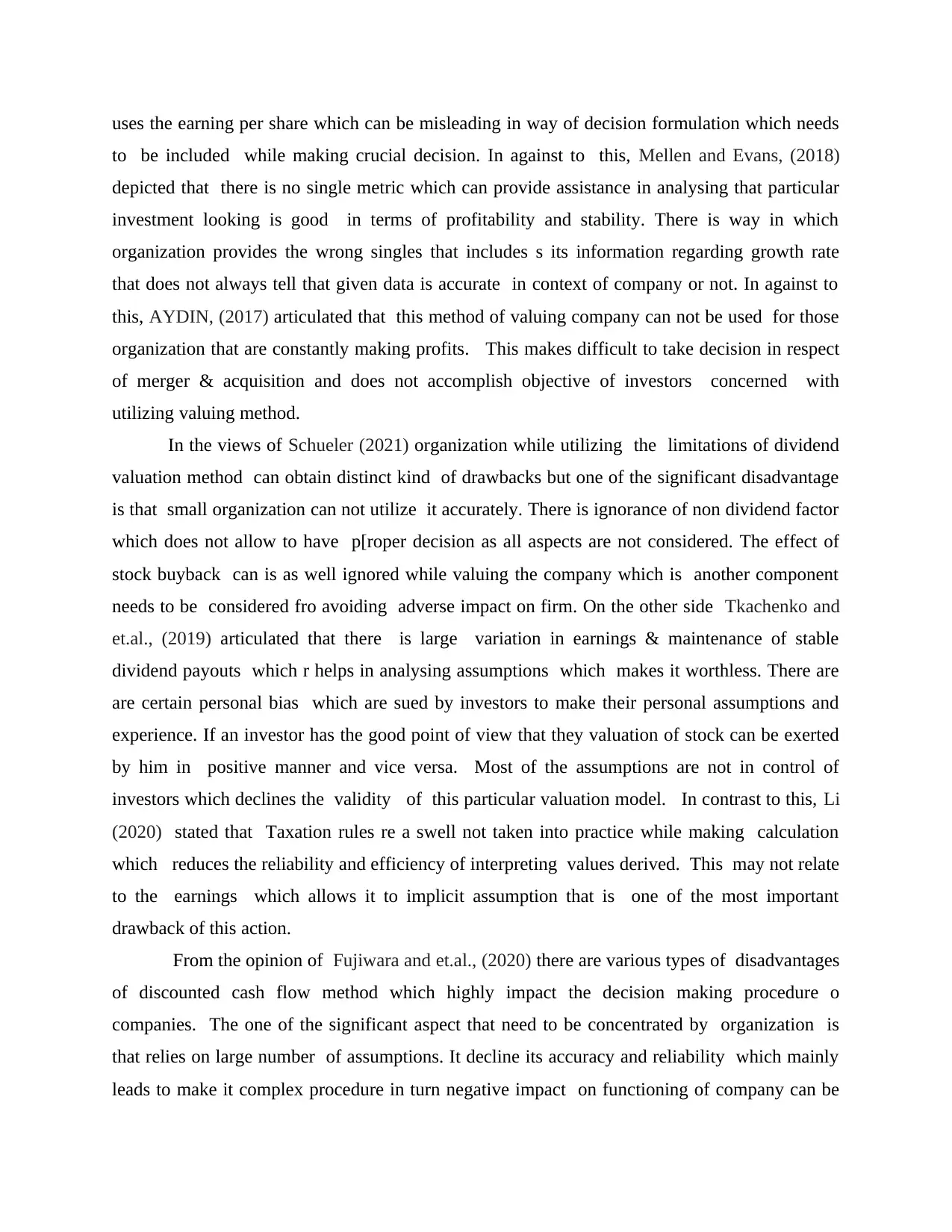
uses the earning per share which can be misleading in way of decision formulation which needs
to be included while making crucial decision. In against to this, Mellen and Evans, (2018)
depicted that there is no single metric which can provide assistance in analysing that particular
investment looking is good in terms of profitability and stability. There is way in which
organization provides the wrong singles that includes s its information regarding growth rate
that does not always tell that given data is accurate in context of company or not. In against to
this, AYDIN, (2017) articulated that this method of valuing company can not be used for those
organization that are constantly making profits. This makes difficult to take decision in respect
of merger & acquisition and does not accomplish objective of investors concerned with
utilizing valuing method.
In the views of Schueler (2021) organization while utilizing the limitations of dividend
valuation method can obtain distinct kind of drawbacks but one of the significant disadvantage
is that small organization can not utilize it accurately. There is ignorance of non dividend factor
which does not allow to have p[roper decision as all aspects are not considered. The effect of
stock buyback can is as well ignored while valuing the company which is another component
needs to be considered fro avoiding adverse impact on firm. On the other side Tkachenko and
et.al., (2019) articulated that there is large variation in earnings & maintenance of stable
dividend payouts which r helps in analysing assumptions which makes it worthless. There are
are certain personal bias which are sued by investors to make their personal assumptions and
experience. If an investor has the good point of view that they valuation of stock can be exerted
by him in positive manner and vice versa. Most of the assumptions are not in control of
investors which declines the validity of this particular valuation model. In contrast to this, Li
(2020) stated that Taxation rules re a swell not taken into practice while making calculation
which reduces the reliability and efficiency of interpreting values derived. This may not relate
to the earnings which allows it to implicit assumption that is one of the most important
drawback of this action.
From the opinion of Fujiwara and et.al., (2020) there are various types of disadvantages
of discounted cash flow method which highly impact the decision making procedure o
companies. The one of the significant aspect that need to be concentrated by organization is
that relies on large number of assumptions. It decline its accuracy and reliability which mainly
leads to make it complex procedure in turn negative impact on functioning of company can be
to be included while making crucial decision. In against to this, Mellen and Evans, (2018)
depicted that there is no single metric which can provide assistance in analysing that particular
investment looking is good in terms of profitability and stability. There is way in which
organization provides the wrong singles that includes s its information regarding growth rate
that does not always tell that given data is accurate in context of company or not. In against to
this, AYDIN, (2017) articulated that this method of valuing company can not be used for those
organization that are constantly making profits. This makes difficult to take decision in respect
of merger & acquisition and does not accomplish objective of investors concerned with
utilizing valuing method.
In the views of Schueler (2021) organization while utilizing the limitations of dividend
valuation method can obtain distinct kind of drawbacks but one of the significant disadvantage
is that small organization can not utilize it accurately. There is ignorance of non dividend factor
which does not allow to have p[roper decision as all aspects are not considered. The effect of
stock buyback can is as well ignored while valuing the company which is another component
needs to be considered fro avoiding adverse impact on firm. On the other side Tkachenko and
et.al., (2019) articulated that there is large variation in earnings & maintenance of stable
dividend payouts which r helps in analysing assumptions which makes it worthless. There are
are certain personal bias which are sued by investors to make their personal assumptions and
experience. If an investor has the good point of view that they valuation of stock can be exerted
by him in positive manner and vice versa. Most of the assumptions are not in control of
investors which declines the validity of this particular valuation model. In contrast to this, Li
(2020) stated that Taxation rules re a swell not taken into practice while making calculation
which reduces the reliability and efficiency of interpreting values derived. This may not relate
to the earnings which allows it to implicit assumption that is one of the most important
drawback of this action.
From the opinion of Fujiwara and et.al., (2020) there are various types of disadvantages
of discounted cash flow method which highly impact the decision making procedure o
companies. The one of the significant aspect that need to be concentrated by organization is
that relies on large number of assumptions. It decline its accuracy and reliability which mainly
leads to make it complex procedure in turn negative impact on functioning of company can be
Paraphrase This Document
Need a fresh take? Get an instant paraphrase of this document with our AI Paraphraser
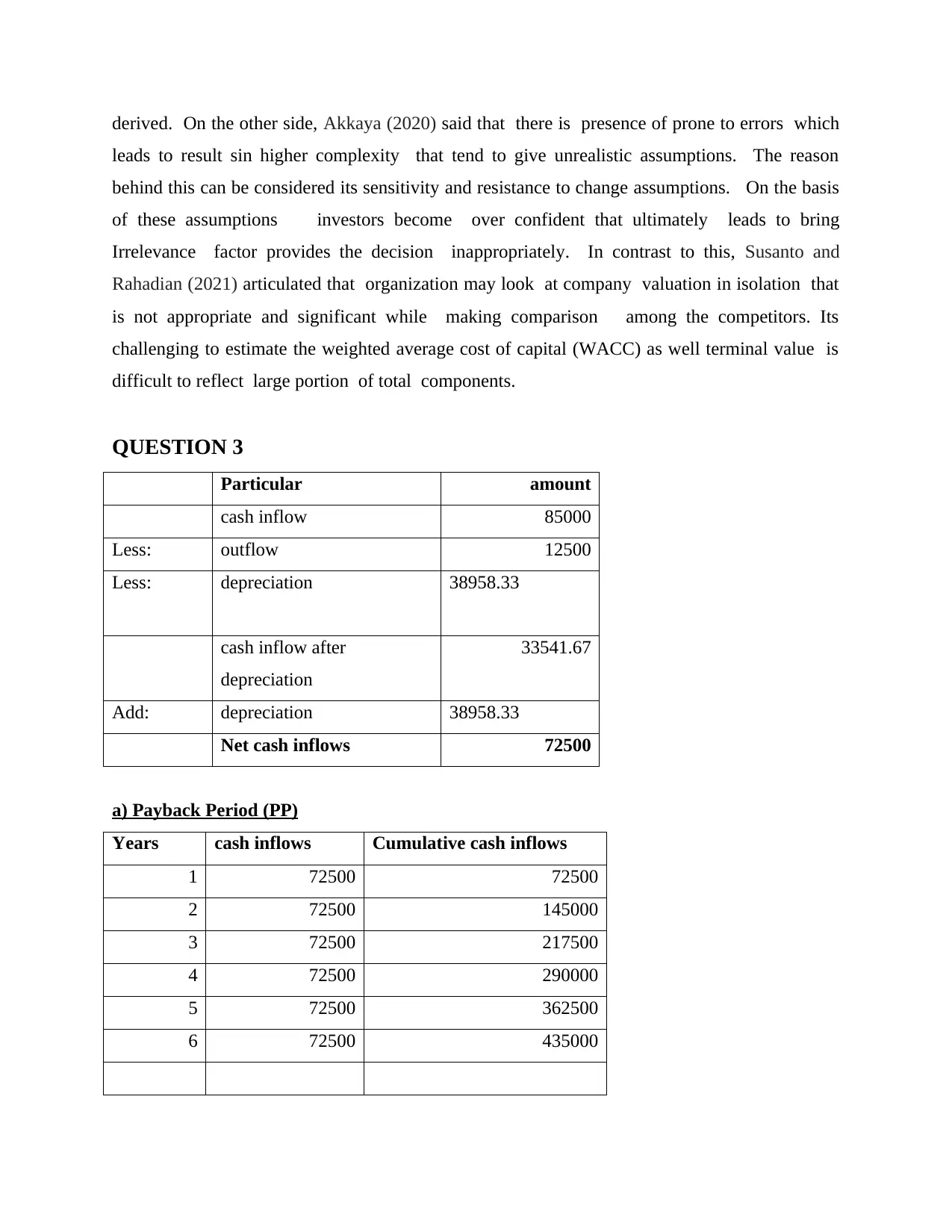
derived. On the other side, Akkaya (2020) said that there is presence of prone to errors which
leads to result sin higher complexity that tend to give unrealistic assumptions. The reason
behind this can be considered its sensitivity and resistance to change assumptions. On the basis
of these assumptions investors become over confident that ultimately leads to bring
Irrelevance factor provides the decision inappropriately. In contrast to this, Susanto and
Rahadian (2021) articulated that organization may look at company valuation in isolation that
is not appropriate and significant while making comparison among the competitors. Its
challenging to estimate the weighted average cost of capital (WACC) as well terminal value is
difficult to reflect large portion of total components.
QUESTION 3
Particular amount
cash inflow 85000
Less: outflow 12500
Less: depreciation 38958.33
cash inflow after
depreciation
33541.67
Add: depreciation 38958.33
Net cash inflows 72500
a) Payback Period (PP)
Years cash inflows Cumulative cash inflows
1 72500 72500
2 72500 145000
3 72500 217500
4 72500 290000
5 72500 362500
6 72500 435000
leads to result sin higher complexity that tend to give unrealistic assumptions. The reason
behind this can be considered its sensitivity and resistance to change assumptions. On the basis
of these assumptions investors become over confident that ultimately leads to bring
Irrelevance factor provides the decision inappropriately. In contrast to this, Susanto and
Rahadian (2021) articulated that organization may look at company valuation in isolation that
is not appropriate and significant while making comparison among the competitors. Its
challenging to estimate the weighted average cost of capital (WACC) as well terminal value is
difficult to reflect large portion of total components.
QUESTION 3
Particular amount
cash inflow 85000
Less: outflow 12500
Less: depreciation 38958.33
cash inflow after
depreciation
33541.67
Add: depreciation 38958.33
Net cash inflows 72500
a) Payback Period (PP)
Years cash inflows Cumulative cash inflows
1 72500 72500
2 72500 145000
3 72500 217500
4 72500 290000
5 72500 362500
6 72500 435000
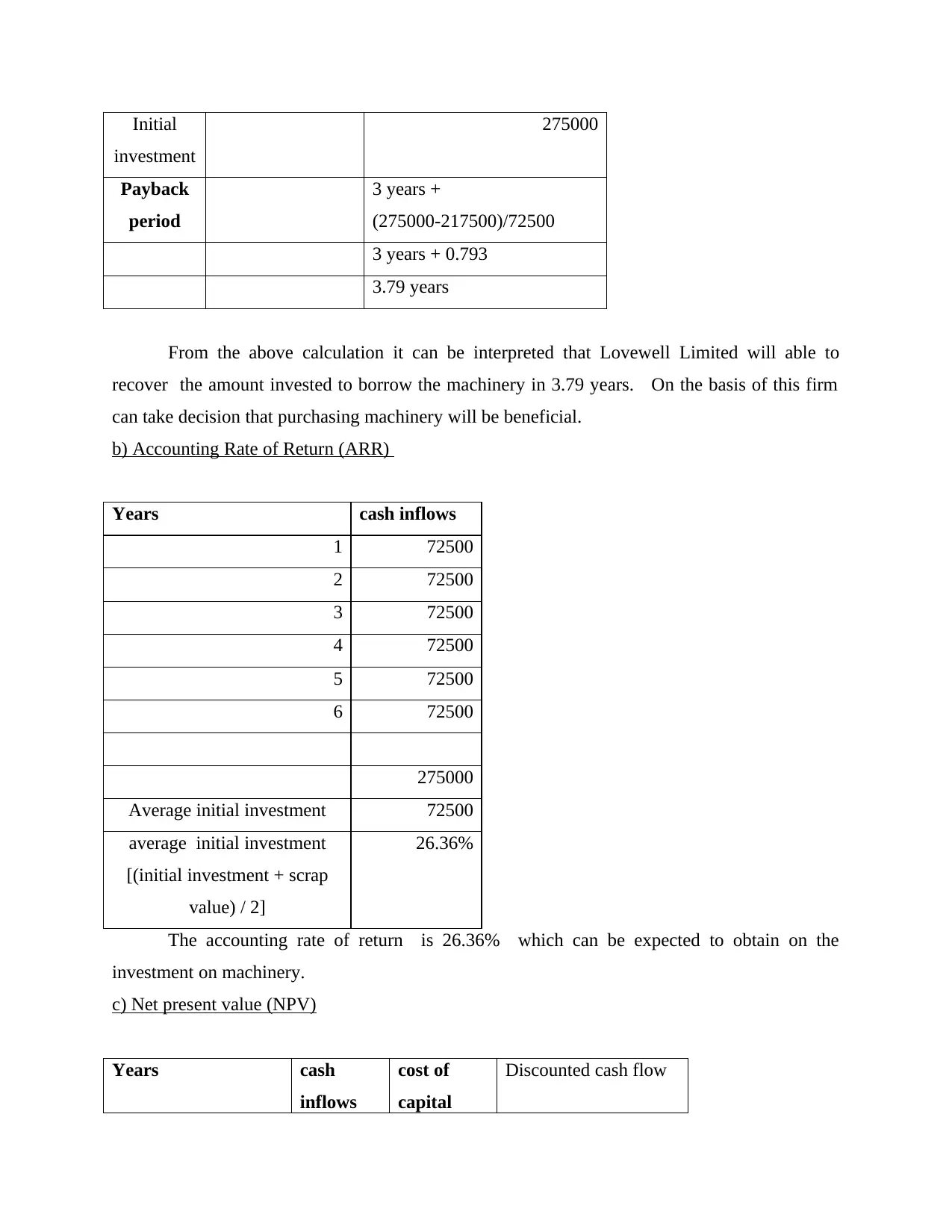
Initial
investment
275000
Payback
period
3 years +
(275000-217500)/72500
3 years + 0.793
3.79 years
From the above calculation it can be interpreted that Lovewell Limited will able to
recover the amount invested to borrow the machinery in 3.79 years. On the basis of this firm
can take decision that purchasing machinery will be beneficial.
b) Accounting Rate of Return (ARR)
Years cash inflows
1 72500
2 72500
3 72500
4 72500
5 72500
6 72500
275000
Average initial investment 72500
average initial investment
[(initial investment + scrap
value) / 2]
26.36%
The accounting rate of return is 26.36% which can be expected to obtain on the
investment on machinery.
c) Net present value (NPV)
Years cash
inflows
cost of
capital
Discounted cash flow
investment
275000
Payback
period
3 years +
(275000-217500)/72500
3 years + 0.793
3.79 years
From the above calculation it can be interpreted that Lovewell Limited will able to
recover the amount invested to borrow the machinery in 3.79 years. On the basis of this firm
can take decision that purchasing machinery will be beneficial.
b) Accounting Rate of Return (ARR)
Years cash inflows
1 72500
2 72500
3 72500
4 72500
5 72500
6 72500
275000
Average initial investment 72500
average initial investment
[(initial investment + scrap
value) / 2]
26.36%
The accounting rate of return is 26.36% which can be expected to obtain on the
investment on machinery.
c) Net present value (NPV)
Years cash
inflows
cost of
capital
Discounted cash flow
⊘ This is a preview!⊘
Do you want full access?
Subscribe today to unlock all pages.

Trusted by 1+ million students worldwide

@12%
1 72500 0.89285714
29
64732.14
2 72500 0.79719387
76
57796.55
3 72500 0.71178024
78
51604.06
4 72500 0.63551807
84
46075.06
5 72500 0.56742685
57
41138.44
6 72500 0.50663112
12
36730.75
Total discounted cash
inflow
298077.03
Initial investment 275000
NPV (Total
discounted cash
inflows - initial
investment)
23077.03
On the basis of above computation it can be articulated that Lovewell Limited will
receive the discounted cash flow of 298077.03 which is higher than the initial investment made
that is 275000. from this it can be articulated that net present value will be 23077.03 that
positive and shows investing in it would be beneficial for the company.
d) Internal Rate of return (IRR)
Years cash inflows
0 -275000
1 72500
2 72500
1 72500 0.89285714
29
64732.14
2 72500 0.79719387
76
57796.55
3 72500 0.71178024
78
51604.06
4 72500 0.63551807
84
46075.06
5 72500 0.56742685
57
41138.44
6 72500 0.50663112
12
36730.75
Total discounted cash
inflow
298077.03
Initial investment 275000
NPV (Total
discounted cash
inflows - initial
investment)
23077.03
On the basis of above computation it can be articulated that Lovewell Limited will
receive the discounted cash flow of 298077.03 which is higher than the initial investment made
that is 275000. from this it can be articulated that net present value will be 23077.03 that
positive and shows investing in it would be beneficial for the company.
d) Internal Rate of return (IRR)
Years cash inflows
0 -275000
1 72500
2 72500
Paraphrase This Document
Need a fresh take? Get an instant paraphrase of this document with our AI Paraphraser

3 72500
4 72500
5 72500
6 72500
IRR 14.92%
From the above illustrated table it can be stated Lovewell Limited can be beneficial by
investing into the particular mentioned machinery for accomplishing its objective. The IRR
obtained from the evaluation is 14.92%.
Analysing economic feasibility of investment
By analysing the capital appraisal technique through presented calculation it can be
identified that company will receive the ability to accomplish its objective of organization (Hu,
2021). In terms of economic feasibility firm will be capable of recovering its invested amounted
within the 3.79 years which is less than given life span of machinery that is positive indication
of investing into the stated kind of project. With help of accounting rate of return it ca be
justified that firm the received accounting rate of return shows that investment is attractive due
to its present result of 26.36% which is higher. On the basis of internal rate of return it can be
identified that 14.92% for 6 years which is higher than the ideal margin that can be taken into
consideration. Discounted cash flows for 6 years are higher than invested initial investment
which is favourable sign for positive inflows. From the analysis of the stated methods it can be
said that economic feasibility will be achieved in terms of higher profitability and ability to
cover all manufacturing expenses (Magni and Marchioni, 2020).
It is recommended that Lovewell Limited should pay attention on purchasing this
particular machinery for gaining higher level of return on its investment. The reason
behind this is higher IRR & ARR which validate firm will receive good amount of
return.
This is advised to the Lovewell Limited to purchase the machinery for getting ability to
decline the cost of manufacturing procedure as the current value after stated years firm
will receive positive inflows.
4 72500
5 72500
6 72500
IRR 14.92%
From the above illustrated table it can be stated Lovewell Limited can be beneficial by
investing into the particular mentioned machinery for accomplishing its objective. The IRR
obtained from the evaluation is 14.92%.
Analysing economic feasibility of investment
By analysing the capital appraisal technique through presented calculation it can be
identified that company will receive the ability to accomplish its objective of organization (Hu,
2021). In terms of economic feasibility firm will be capable of recovering its invested amounted
within the 3.79 years which is less than given life span of machinery that is positive indication
of investing into the stated kind of project. With help of accounting rate of return it ca be
justified that firm the received accounting rate of return shows that investment is attractive due
to its present result of 26.36% which is higher. On the basis of internal rate of return it can be
identified that 14.92% for 6 years which is higher than the ideal margin that can be taken into
consideration. Discounted cash flows for 6 years are higher than invested initial investment
which is favourable sign for positive inflows. From the analysis of the stated methods it can be
said that economic feasibility will be achieved in terms of higher profitability and ability to
cover all manufacturing expenses (Magni and Marchioni, 2020).
It is recommended that Lovewell Limited should pay attention on purchasing this
particular machinery for gaining higher level of return on its investment. The reason
behind this is higher IRR & ARR which validate firm will receive good amount of
return.
This is advised to the Lovewell Limited to purchase the machinery for getting ability to
decline the cost of manufacturing procedure as the current value after stated years firm
will receive positive inflows.
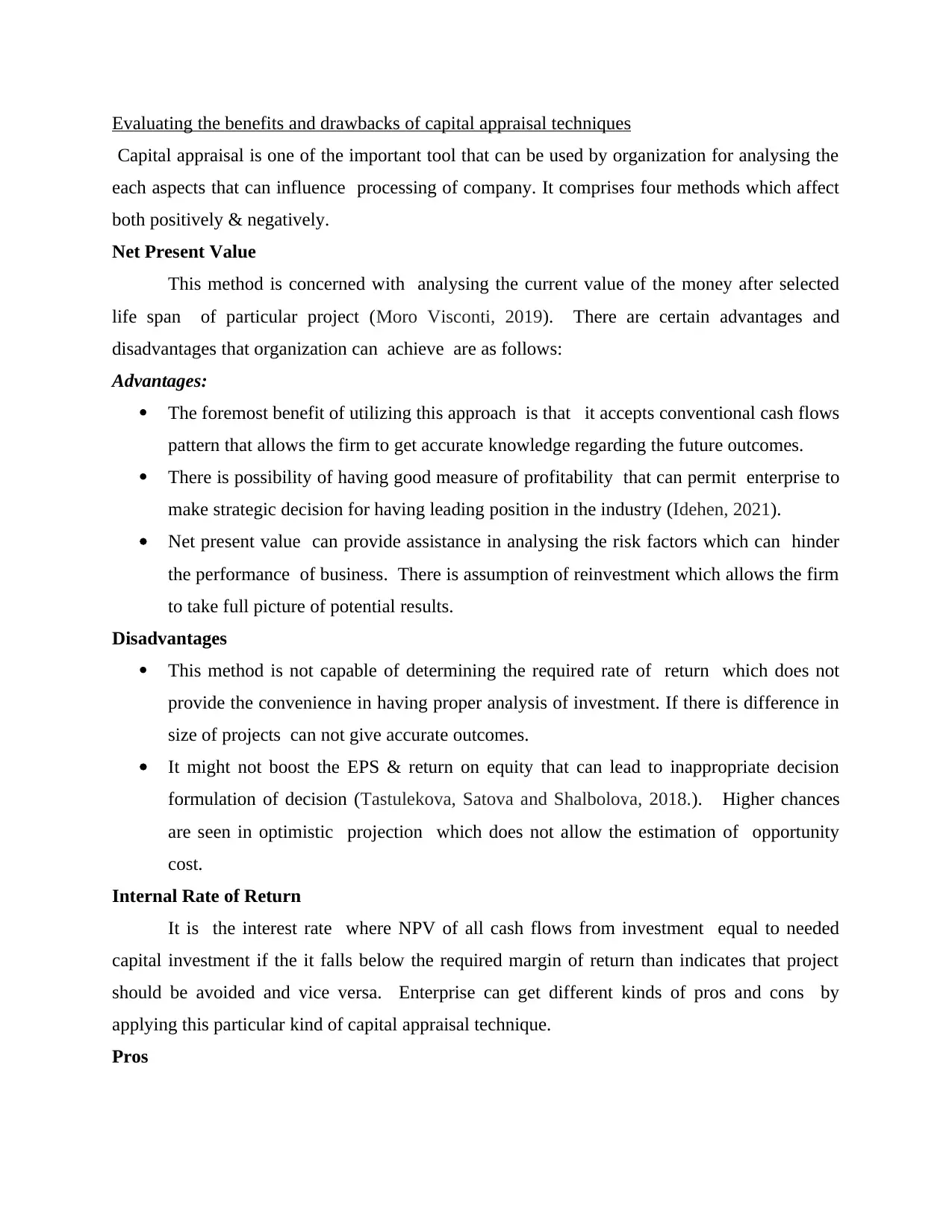
Evaluating the benefits and drawbacks of capital appraisal techniques
Capital appraisal is one of the important tool that can be used by organization for analysing the
each aspects that can influence processing of company. It comprises four methods which affect
both positively & negatively.
Net Present Value
This method is concerned with analysing the current value of the money after selected
life span of particular project (Moro Visconti, 2019). There are certain advantages and
disadvantages that organization can achieve are as follows:
Advantages:
The foremost benefit of utilizing this approach is that it accepts conventional cash flows
pattern that allows the firm to get accurate knowledge regarding the future outcomes.
There is possibility of having good measure of profitability that can permit enterprise to
make strategic decision for having leading position in the industry (Idehen, 2021).
Net present value can provide assistance in analysing the risk factors which can hinder
the performance of business. There is assumption of reinvestment which allows the firm
to take full picture of potential results.
Disadvantages
This method is not capable of determining the required rate of return which does not
provide the convenience in having proper analysis of investment. If there is difference in
size of projects can not give accurate outcomes.
It might not boost the EPS & return on equity that can lead to inappropriate decision
formulation of decision (Tastulekova, Satova and Shalbolova, 2018.). Higher chances
are seen in optimistic projection which does not allow the estimation of opportunity
cost.
Internal Rate of Return
It is the interest rate where NPV of all cash flows from investment equal to needed
capital investment if the it falls below the required margin of return than indicates that project
should be avoided and vice versa. Enterprise can get different kinds of pros and cons by
applying this particular kind of capital appraisal technique.
Pros
Capital appraisal is one of the important tool that can be used by organization for analysing the
each aspects that can influence processing of company. It comprises four methods which affect
both positively & negatively.
Net Present Value
This method is concerned with analysing the current value of the money after selected
life span of particular project (Moro Visconti, 2019). There are certain advantages and
disadvantages that organization can achieve are as follows:
Advantages:
The foremost benefit of utilizing this approach is that it accepts conventional cash flows
pattern that allows the firm to get accurate knowledge regarding the future outcomes.
There is possibility of having good measure of profitability that can permit enterprise to
make strategic decision for having leading position in the industry (Idehen, 2021).
Net present value can provide assistance in analysing the risk factors which can hinder
the performance of business. There is assumption of reinvestment which allows the firm
to take full picture of potential results.
Disadvantages
This method is not capable of determining the required rate of return which does not
provide the convenience in having proper analysis of investment. If there is difference in
size of projects can not give accurate outcomes.
It might not boost the EPS & return on equity that can lead to inappropriate decision
formulation of decision (Tastulekova, Satova and Shalbolova, 2018.). Higher chances
are seen in optimistic projection which does not allow the estimation of opportunity
cost.
Internal Rate of Return
It is the interest rate where NPV of all cash flows from investment equal to needed
capital investment if the it falls below the required margin of return than indicates that project
should be avoided and vice versa. Enterprise can get different kinds of pros and cons by
applying this particular kind of capital appraisal technique.
Pros
⊘ This is a preview!⊘
Do you want full access?
Subscribe today to unlock all pages.

Trusted by 1+ million students worldwide
1 out of 16
Related Documents
Your All-in-One AI-Powered Toolkit for Academic Success.
+13062052269
info@desklib.com
Available 24*7 on WhatsApp / Email
![[object Object]](/_next/static/media/star-bottom.7253800d.svg)
Unlock your academic potential
Copyright © 2020–2025 A2Z Services. All Rights Reserved. Developed and managed by ZUCOL.





